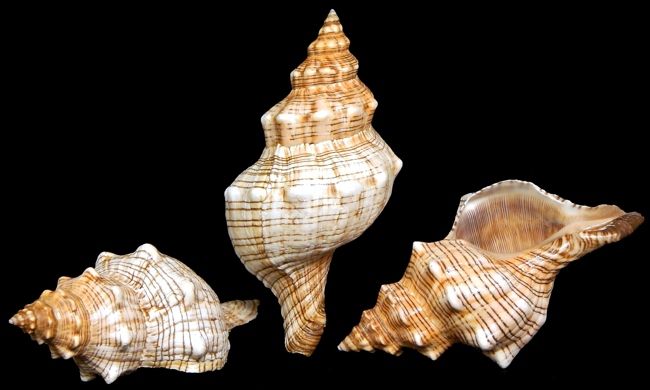As the site is updated, each listing includes the shipping cost. Some listings which I have not updated still give you calculated shipping costs based on weight and size of package. (In the sections I have updated) If you select several different listings, we will consolidate your order and charge you the actual cost of the entire package. The shipping over charge will be refunded to you, when your order is shipped.
FOX SHELLS OF THE WESTERN PACIFIC MANY SIZES AND DISCOUNT PRICES

Pleuroploca trapezium, common name : the trapezium horse conch or striped fox conch
The striped fox conch is a species of sea snail, a marine gastropod mollusk in the family Fasciolariidae, the spindle snails & the tulip snails.
(REF: Pleuroploca trapezium (Linnaeus, 1758)
These shells are coveted for food and used as a trumpet when the tip of the spire is cut off.
The golden brown shell is solid and heavy. Its shell size varies between 3 to 10 inches with a common length of a little over 7 inches. The spire is of moderate length. The apex is usually eroded. The sutures are constricted. The shoulders on the whorls are covered with spiral rows of slightly pointed strong nodules. The surface is covered with fine, brown, incised spiral lines, mainly in pairs. The outer lip is dentate with seven pairs of teeth (these are carnivores), situated where the paired lines meet the edge. The oval aperture is pale with strong ridges internally. The columella is smooth posteriorly. The siphonal canal is extended and short. The fasciole is weak.
(REF: Pleuroploca trapezium (Linnaeus, 1758))
These shells are found in the Red Sea, across the Indo-Pacific region from Japan to Melanesia, New Caledonia and North to Queensland. They are also found along Aldabra Atolls of Seychelles, Madagascar, Mauritius, Mozambique, Réunion (France), South Africa and Tanzania.
This species dwells in the benthic zone on seagrass beds at depths between 0 to 132 feet.
The benthic zone is the ecological region at the lowest level of a body of water such as an ocean, lake, or stream, including the sediment surface and some sub-surface layers. The name comes from ancient Greek, βένθος (bénthos), meaning the depths. Organisms living in this zone are called benthos and include microorganisms (e.g., bacteria and fungi) as well as larger invertebrates, such as crustaceans and polychaetes. Organisms here generally live in close relationship with the substrate and many are permanently attached to the bottom. The benthic boundary layer, which includes the bottom layer of water and the uppermost layer of sediment directly influenced by the overlying water, is an integral part of the benthic zone, as it greatly influences the biological activity that takes place there. Examples of contact soil layers include sand bottoms, rocky outcrops, coral, and bay mud.
(REF: Richard (Joseph R.) Houbrick, Growth Studies on the Genus Ceirhium (Gastropoda: Prosobranchia) with notes on ecology and microhabitats; The Nautilus, vol 88, 1, January 1974.)
Scientific classification
Kingdom: Animalia
Phylum: Mollusca
Class: Gastropoda
(unranked): clade Caenogastropoda
clade Hypsogastropoda
clade Neogastropoda
Super family: Buccinoidea
Family: Fasciolariidae
Genus: Pleuroploca
Species: P. trapezium
Binomial name: Pleuroploca trapezium
Binomial name: Pleuroploca Trapezium ( Linnaeus, 1758)A1-6
One Fox shell, measuring 3 to 5 inches. .......$6.95
xA1-6
Five Fox shells, measuring 3 to 5 inches. .......$12.25
xxA1-6
Twelve Fox shells, measuring 3 to 5 inches. .......$23.95
A2-6
One Striped Fox Shell measuring 5 to 6 inches...... $6.95
A3-6
A Striped Fox shell, measuring 6 and 7 inches. ...... $10.95
A4-6
One Striped Fox shell 8 inches or more...…OUT OF STOCK
A5-6
One Striped Fox Shell approximately 8 inches.....OUT OF STOCK